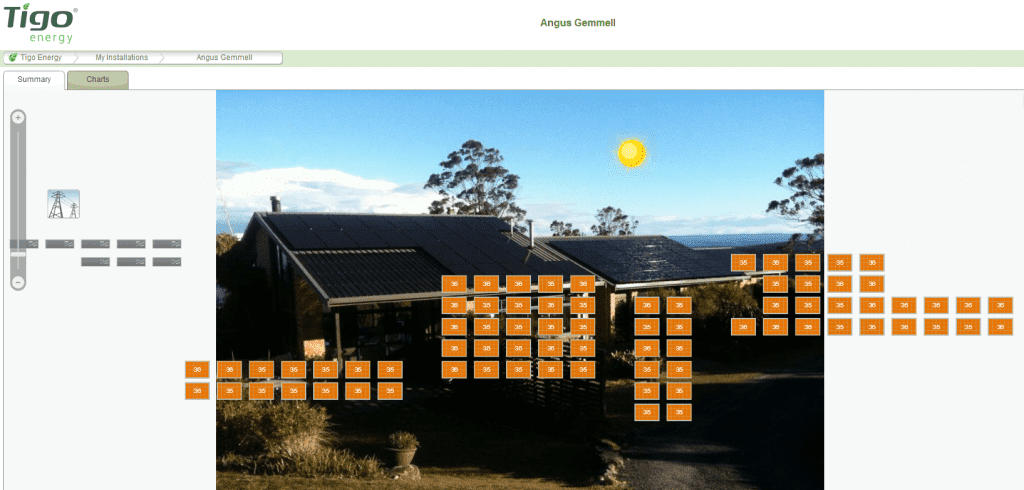As a demonstration project for Solar Choice’s 80,000 residential solar customers on how to maximise roof potential for solar energy despite restrictions from utilities, Solar Choice’s Managing Director, Angus Gemmell, has had a 22kW solar PV system installed at his farm on the Kangaroo Valley escarpment. At this point in time, only 2kW of the system’s capacity is currently grid-connected, with plans to connect the remaining capacity after outstanding network connection issues have been resolved.
Collaborative dialogue is underway with Vince Graham, the Head of Networks NSW (the peak body for Ausgrid, Endeavour Energy and Essential Energy), as well as engineers at Endeavour Energy, on how to solve voltage rise concerns to allow grid connection for up to 16kW despite a cap of 5KW for properties with single-phase power. The remaining 6kW will be diverted to battery storage.
The site will provide an ongoing demonstration for the viability of grid-connected energy storage, as well as a case study for innovative ways of addressing the issue of voltage rise in grid-connect solar systems. The system is comprised of LG modules with Tigo DC optimisers for individual panel monitoring. (System performance can be viewed via the Tigo web portal–noting that until grid connection and/or battery storage is resolved the output will show voltage readings but no power generation.)
A snapshot from the Tigo web portal for the demonstation project.
As the property has only a single phase connection to the grid, Endeavour Energy are concerned that a large PV system’s electricity output could result in unacceptable voltage rise on the network to over 253V. This is not an issue unique to this system. Across Australia, utilities and network operators have pointed out the potential and actual complications that could occur due to an overload of solar on the grid–and many have already sought to address the problem.
In Queensland, for example, utilities have essentially set rules under which the installation of a solar system without an export control device will result in additional bureaucratic hurdles for solar homes. Across the continent on WA’s Horizon Power network, regional capacity caps have been put in place to deal with the issue.
The problem has also raised its head in NSW, where local network companies have mandated site assessments for homes & businesses who install solar systems over a certain capacity, depending on the phase.
A potential resolution has nevertheless been found: The tap on the transformer (located above the meter board on the property) could be adjusted down to 225V-230V by Endeavour Energy, allowing 16kW of the system to be safely connected at 253V. This is, Solar Choice has been informed, a relatively straightforward procedure, and although it may be associated with a fee, could serve as a viable, blanket solution for all properties serviced by a dedicated inverter, and may also act as a template for facilitating the connection of solar PV systems across the network more generally.
Solar Choice, after having voltage rise calculated for three potential system connection options (5kW, 16kW and 22kW) has reached out to Endeavour Energy about this solution and is awaiting a response.
Preventing grid defection in the face of falling energy storage costs
Rooftop solar, energy efficiency and energy storage are set to play an increasingly important role in Australia’s electricity infrastructure. Already, the first two of these three are credited as having had a huge impact on grid electricity demand, which has been sinking steadily across the country. The third–energy storage–is tipped to grow exponentially in the coming years.
As network companies implement more reactive measures to tackle the issue of voltage rise, they are also–intentionally or inadvertently–pushing consumers into the arms of solar power and energy storage providers, whose allure grows as technology prices fall. The more capacity homes and businesses have for generating their own electricity, the less they will require from the grid–in some cases they may even become wholly energy-independent, disconnecting from the grid altogether.
This could result in a phenomenon that has been referred to as a ‘death spiral‘, where utilities raise fees to compensate for lost revenues due to grid defection, which in turn leads to even more homes and businesses turning to non-grid alternatives. The pattern is unsustainable and undesirable for both utilities and consumers.
With Endeavour’s current solar connection rules, the temptation for consumers to circumvent the current 5kW cap on PV systems for single phase properties (by maximising roof space for panels and opting for financed battery storage) will soon prove irresistible en masse. As even conservative commentators contend, applying a blanket and indiscriminate 5kW ceiling could create a spiral of disconnections.
However, if the 5kW cap could be solved through site-specific attention to voltage rise concerns to allow substantially larger PV systems to safely export to the grid, this would be of vital short and long-term benefit to both utilities and consumers. The deployment of the 22kW demonstration system will hopefully be an excellent example of one way to address voltage rise–while also staying grid-connected with storage.
© 2014 Solar Choice Pty Ltd




